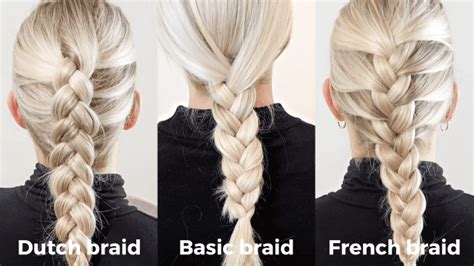Introduction

Braiding, an intricate art that has adorned heads for centuries, invites you on a captivating journey of exploring two iconic techniques: the French braid and its captivating Dutch counterpart. This comprehensive guide delves into the subtleties of each technique, empowering you to master these beautiful hair designs.
French Braid
- Origin and Intricacy: Originating in France, this classic braid involves intricately weaving three strands of hair together, creating an elegant and timeless look.
- Technique: Starting at the top of the head, separate a small section of hair into three equal strands. Cross the right strand over the middle strand, then cross the left strand over the new middle strand. Repeat this process, gradually incorporating more hair from the sides into the braid as you work down the head.
- Advantages: French braids are versatile, complementing a wide range of outfits and occasions. They offer secure hold, keeping your hair in place all day long.
- Variations: Experiment with different variations, such as the inverted French braid (starting at the nape) or the fishtail braid (dividing each strand into two before braiding).
Dutch Braid
- Origin and Distinction: Dutch braids, also known as “inside-out” braids, originated in the Netherlands. Their distinct characteristic lies in the strands being woven under rather than over, creating an elevated and voluminous effect.
- Technique: Similar to the French braid, start by dividing a section of hair into three. But instead of crossing the strands over each other, cross them under the middle strand. Continue this process, incorporating additional hair from the sides into the braid.
- Advantages: Dutch braids provide exceptional volume and texture, making them ideal for adding fullness to fine or limp hair. They are also a captivating choice for braids that lie closer to the scalp.
- Variations: Explore variations such as the double Dutch braid (creating two parallel Dutch braids) or the four-strand Dutch braid (incorporating an additional strand from the sides).
Comparison: French vs Dutch Braid
Table 1: Features and Techniques
| Feature | French Braid | Dutch Braid |
|---|---|---|
| Weaving Technique | Over | Under |
| Effect | Clean and elegant | Voluminous and textured |
| Hold | Secure | Elevated |
Table 2: Best Hair Types for Braiding
| Hair Type | French Braid | Dutch Braid |
|---|---|---|
| Fine or limp hair | Ideal | Excellent for adding volume |
| Thick or coarse hair | Suitable | Can handle the bulkier construction |
| Short hair (below shoulders) | Limited options | Not recommended |
| Long hair (below mid-back) | Optimal | Ideal for creating stunning braids |
Benefits of Braiding
- Hair Health: Braiding protects hair from breakage, tangles, and damage caused by environmental factors and excessive brushing.
- Versatility: Braids offer endless styling possibilities, from casual everyday looks to elegant updos.
- Time-Saving: Braids can save precious time on busy mornings, providing a chic and effortless hairstyle that lasts for several days.
- Scalp Relief: Braids can distribute the weight of hair evenly, reducing tension on the scalp and alleviating headaches.
Applications Beyond Appearance
The art of braiding not only enhances our appearance but also has unexplored potential in various fields:
- Medical: Scalp braids can assist in wound healing, prevent hair loss during chemotherapy, and manage pressure ulcers.
- Athletic: Braids provide secure and non-obstructive hairstyles for athletes, reducing hair tangles and discomfort during physical activities.
- Artistic: Braids can be used as a creative medium for hair designs, creating intricate patterns and embellishments.
- Social Impact: Braiding workshops and competitions empower individuals, especially in underserved communities, by promoting cultural appreciation and income-generating opportunities.
Table 3: Braiding in Different Cultures
| Culture | Braiding Practices |
|---|---|
| Africa | Intricate cornrows and locs |
| Asia | Elaborate buns with intricate hair accessories |
| Europe | Braided crowns and updos |
| South America | Colorful ribbons and flowers woven into braids |
Table 4: Celebrities Who Rock Braids
| Celebrity | Braid Style |
|---|---|
| Beyonce | Cornrows |
| Jennifer Lopez | Dutch braids |
| Emma Watson | French braids |
| Zendaya | Fishtail braids |
Conclusion
French and Dutch braids, each with its unique charm and advantages, offer a boundless canvas for hair artistry. By understanding the techniques, benefits, and endless possibilities of braiding, you can unleash your creativity and embrace the transformative power of these iconic hairstyles. Whether you crave the timeless elegance of the French braid or the voluminous impact of the Dutch braid, this comprehensive guide empowers you to master these beautiful and versatile techniques.
Questions to Engage Readers
- Which braiding technique do you prefer and why?
- How do you incorporate braids into your everyday hairstyles?
- Are there any additional benefits of braiding that you have experienced?
- What innovative applications of braiding can you envision beyond aesthetic purposes?
Remember, braiding is not just about aesthetics; it is an art form that can empower, inspire, and connect us with cultures worldwide. Embrace the beauty and versatility of braids and let your creativity shine through!
